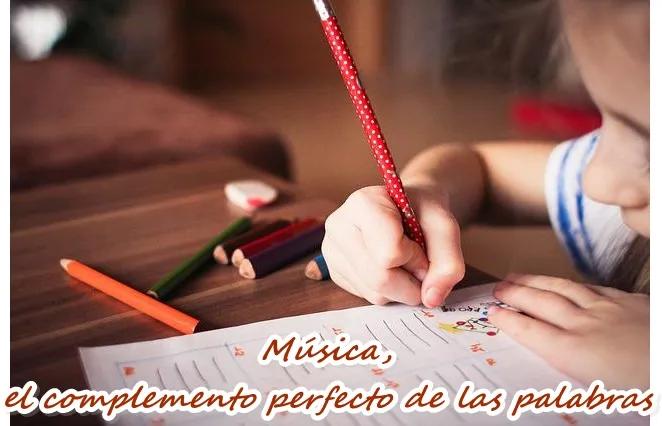Hola amigos especiales!

English translation: "Music, the perfect complement of words." Esther
Aunque para algunos la única visión que tengan de la música, sea desde el punto de vista recreativo (punto muy válido) los que hemos experimentado un poco más con ella, utilizándola como complemento de nuestras actividades diarias y como herramienta para la educación/aprendizaje, hemos descubierto lo amplio y diverso de su universo.
"La música es el estímulo humano que más partes del cerebro activa. La exposición a la música desde el vientre materno y muy especialmente la música clásica, tiene efectos positivos en los niños. Como ya mencionamos, los efectos positivos de la música en los niños, se relacionan con el aumento de la memoria y la concentración. La música es una actividad recreativa y académica, qué desde temprana edad, les encanta a los niños y que a la vez refuerza características como la fluidez de expresión. Por lo tanto, la música y el cerebro están estrechamente relacionados".
Although for some the only vision they have of music is from a recreational point of view (a very valid point), those of us who have experimented a little more with it, using it as a complement to our daily activities and as a tool for education/learning, have discovered how wide and diverse its universe is. "Music is the human stimulus that activates the most parts of the brain. Exposure to music from the womb, and especially classical music, has positive effects on children. As already mentioned, the positive effects of music on children are related to increased memory and concentration. Music is a recreational and academic activity, which from an early age, children love and which at the same time reinforces characteristics such as fluency of expression. Therefore, music and the brain are closely related.
El siguiente es un video que hice con uno de mis gemelos hace algún tiempo cuando comenzaban en la escritura. Estos ejercicios que realizaban, los repetían 5 veces cada uno y les colocaba una música tranquila de fondo como acompañamiento en su jornada. Ustedes pueden utilizar aquella con la que observen les permita estar tranquilos (puede ser con letra o simplemente instrumental).
Antes de cada ejercicio, ya sea de lectura o escritura, nuestros niños requieren entrar en contexto y ubicarse en lo que harán a continuación, pero para ello necesitan estar relajados, con su mente quieta y preparada para recibir la información de manera que fluya el aprendizaje en su cerebro.
The following is a video I made with one of my twins some time ago when they were beginning to write. These exercises they did, they repeated them 5 times each and I played quiet music in the background to accompany them in their day. You can use whatever music you observe allows them to be calm (it can be with lyrics or simply instrumental).Before each exercise, whether it is reading or writing, our children need to get into context and place themselves in what they are going to do next, but for this they need to be relaxed, with their mind still and ready to receive the information so that the learning flows in their brain.
Como material de trabajo, puedes utilizar marcadores, lápices y/o creyones, una regla; también, puedes utilizar un compás u objetos circulares de diferente tamaño. Lo que buscamos con este ejercicio, además de reforzar la concentración, es ejercitar su motricidad fina, acentuar la fluidez de los movimientos de sus manos en la hoja de trabajo.Contrariamente a lo que muchos piensan, no es un prerrequisito el conocimiento musical para aplicar estos ejercicios, tampoco tener experiencia docente. Lo que si es condición vital es estar conscientes de la capacidad de nuestros niños, de que su tiempo no es el nuestro y es con el de ellos que trabajamos, que primero tenemos que estar revestidos de paciencia y mucho amor antes de comenzar . Necesitamos sentir y mostrar empatía y hacer refuerzos positivos todo el tiempo, nutrir su autoestima.En una ocasión Mandela expresó: «La educación es el arma más poderosa para cambiar el mundo». Nosotros solemos decir que cada cabeza es un mundo y si lo pensamos objetivamente, basándonos en este pensamiento, si podemos hacerlo. Esa cabecita que tenemos en casa es un pequeño mundo, y si lo ayudamos, estaríamos cambiando su mundo.As working material, you can use markers, pencils and/or crayons, a ruler; you can also use a compass or circular objects of different sizes. What we are looking for with this exercise, apart from reinforcing concentration, is to exercise their fine motor skills, to accentuate the fluidity of their hand movements on the worksheet. Contrary to what many people think, musical knowledge is not a prerequisite to apply these exercises, nor is teaching experience. What is a vital condition is to be aware of the capacity of our children, that their time is not ours and it is with their time that we work, that we first have to be armed with patience and a lot of love before we start. We need to feel and show empathy and do positive reinforcement all the time, nurture their self-esteem. Mandela once said "Education is the most powerful weapon to change the world". We use to say that every head is a world and if we think objectively, based on this thought, we can change it. That little head we have at home is a small world, and if we help it, we would be changing its world.
Agradezco tu visita y el aporte de tu opinión Hasta la próxima vez
I appreciate your visit and the contribution of your opinion.
Until next time!

